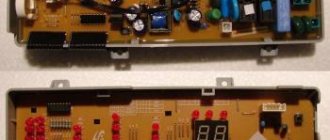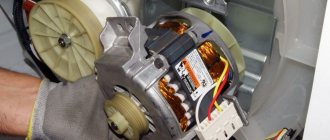It is very difficult to imagine a modern apartment without an automatic washing machine. This household invention has become a reliable assistant for housewives who can simply load dirty laundry, set the required washing mode, turn on the unit and do other household chores. The assistant will do all the work independently and automatically.
But any household appliance is not immune to the occurrence of various malfunctions, which can bring a lot of concern to users. Therefore, if you find that the washing machine is constantly taking in water, you need to establish the cause of the possible breakdown and decide how to fix it. Delay in solving this problem can lead to more serious troubles.
Possible consequences of a malfunction
During operation, the machine can draw water at least twice, since any mode involves the washing process itself, as well as rinsing the laundry. Of course, depending on the selected operating mode, the number of cycles of adding and draining water may increase, which is a normal technological process. Concern should arise when the washing machine constantly fills with water, which is one of the most unpleasant and dangerous breakdowns.
When the drainage system is functioning correctly, the unit will remove water from the tank. But if the drain is clogged, the electronic control may fail or flood the neighboring residents. In addition to economic losses (increased water consumption), this situation leads to a heavy load on the main components and parts of the machine, which causes their premature wear. Especially if the Indesit washing machine constantly takes in water, the heating element suffers, which is connected very often.
In any case, operating a washing machine with uncontrolled filling of water is prohibited, as this may cause damage to other components of the unit.
Reasons why a washing machine fills with water and immediately drains
As we have already found out, the reasons for this behavior of household appliances can be either problems with incorrect installation or with the internal components and parts of the washing machine. This process can go on endlessly until the cause is eliminated.
The washing machine is not connected correctly
If you connect the washing machine yourself, the drain hose may not be installed correctly. Its end should be at a height equal to half the body of the machine. This is about 50-60 cm from the floor. If the hose is lying on the floor, then under the influence of pressure the water will flow out by gravity. An antisiphon will help solve this problem.
The sewer is clogged
If an impassable blockage has formed in the general house sewer system, then when waste is drained, low pressure will form in the pipe. This causes water to flow from the car tank into the sewer system to equalize the pressure in the pipes. The amount of water in the tank decreases, the water level sensor sends a signal that more water needs to be added, and water filling begins.
This problem can be solved simply: either clean the sewer (you will have to do this anyway), or disconnect the drain pipe of the machine from the sewer and drain it into the bathtub or toilet.
Breakdown of the pressure switch
The command to fill the tank with water does not reach the control unit due to a faulty water level sensor. The sensor tube may be clogged, or the part itself may be damaged. The problem is solved inside the washing machine. If the problem is a blockage, then simply clean the tube from dust and dirt. And if the problem is with the pressure switch, then it is better to replace it. Repairs can only solve the problem for a short time.
The inlet valve is faulty
Diagnosing this problem is simple: the machine is turned off and water is poured into it. This is evidenced by the characteristic noise of water in the pipes. If water is drawn slowly, then the problem is in the inlet valve diaphragm. But intensive water intake indicates the need to replace the valve itself. The intake valve is not repaired. A new part is put in its place.
The washing machine tank is leaking
If, when the equipment is operating, a large puddle is discovered underneath it, then a problem with the constant supply of water may occur due to holes in the machine’s tank. Sometimes the gasket between the walls of the tank does not fit tightly, and water leaks out. Although the tank body looks strong, it can be easily damaged by sharp or hard objects forgotten in pockets when washing things. If the hole is small, you can seal it with sealant. As a temporary solution to the problem, this method is suitable. If the damage to the drum is significant, then it is better to install a new tank at a service center.
The electronic module has failed
In modern washing machines, the control unit issues commands to various systems and controls their execution. If the block is broken, the entire operation of the machine is disrupted. Commands are either not executed or executed incorrectly. The causes of block failure are high humidity and mechanical damage. This part is replaced at a service center.
Reasons for uncontrolled water intake
It is not difficult to notice that the Ariston washing machine constantly fills with water. After collection, the water is constantly drained into the sewer, which is accompanied by the incessant noise of the liquid being removed, and also greatly lengthens the process of washing clothes.
The most common reasons why a washing machine constantly fills with water are:
- Incorrect connection of the washing machine during installation.
- Damage to the filler (inlet) or outlet valve.
- Malfunction of the liquid level sensor (pressostat).
- Failure in the electronic control system.
Incorrect sewer connection
Particular attention should be paid to the correct connection of the washing unit during first installation or after moving the machine to another location.
A reasonable question arises: the washing machine constantly fills with water, what should I do? It is considered that the device is connected correctly if the drain hose is connected to the sewer through a siphon. The working end of the device should be located above the machine drum, i.e. at a height of about 60 cm from the floor surface. This arrangement completely eliminates spontaneous leakage of water from the tank. Otherwise, the Samsung washing machine constantly draws water, since the level sensor is triggered when the water level drops and sends a signal to the pump to pump up liquid. At the same time, the washing cycle increases in time and the quality of work suffers.
“Symptoms” of a breakdown
As a standard, during the washing process, the automatic machine fills and drains water several times (usually 2-3). It is difficult not to notice that liquid enters the system continuously. The main “symptoms” noted by users in this situation:
- the incessant noise of water being collected;
- extended washing program. Since the process is not carried out correctly, the cycle time increases;
- At the end of washing, the clothes are still dirty, with soap smudges. This is observed because the required concentration of the soap solution is not achieved.
It is worth eliminating the reason for the machine’s constant intake of water immediately after identifying the problem.
It is dangerous to operate the washing machine with such a violation. This can lead to complete equipment failure.
Checking the unit installation
After installing the unit, it is recommended to check that it is installed correctly. The visual method is applicable in rooms where there is free access to the elements of the drainage system.
If it is impossible to control the level of the drain hose due to natural obstacles, you can check the correct installation using an experimental method. To do this, you need to set the normal washing mode and wait until the tank is filled with water. Next, turn on the drain and set a pause after 5-7 seconds.
For some time you need to monitor the liquid level in the tank. If the water level remains at the same level, then the machine is connected correctly. An incorrect connection will be indicated by the characteristic murmur of water in the pipes.
What could have gone wrong?
Various factors can cause the Indesit machine to constantly fill with water. Initially, you should identify all possible problems, and during the diagnostic process, narrow down the range of breakdowns. So, what can cause a continuous supply of liquid from the water supply:
- incorrect connection of the washing machine;
- damaged washing machine tank;
- broken pressure switch;
- broken intake solenoid valve;
- faulty control module.
If only the purchased machine showed a problem in the first wash, it is not necessary that it was connected incorrectly. Perhaps there is a normal manufacturing defect. In this case, it is better not to carry out repairs yourself, but to submit the equipment for warranty service to a service center.
Sewer blockage
Also, the washing machine constantly draws water if the general sewer is clogged. This siphon effect occurs as a result of the appearance of rarefied pressure when neighbors in the riser use the sewer. This pressure is sufficient for periodic pumping of liquid from the tank of the washing unit.
Installing a special low-power valve (anti-siphon) on the drain hose allows you to get rid of this harmful circumstance.
A temporary preventative measure is to disconnect the drain from the siphon and install it in the bathtub or sink when washing.
Damage to the main tank
A crack in the tank of an Indesit washing machine is far from uncommon. Finding out about a hole is easy - water will accumulate under the washer during washing. This breakdown is very dangerous, as it can cause a flood in the apartment, causing damage not only to your home, but also to your neighbor’s.
The most dangerous cracks appear at the bottom of the tank. Holes in the upper part are not so bad, because in this case the water will not flow onto the floor - most Indesit programs provide for only half filling the drum with water. To inspect the bottom of the tank:
- Turn off the power to the washing machine, disconnect the inlet and drain hoses from the communication terminals;
- drain the water from the tank (through a garbage filter or drain hose);
- move the machine to the middle of the room (the ideal place for repairs would be the garage);
- place the washing machine on its right side;
- inspect the bottom of the tank. You can use a marker to mark suspicious places that look like holes.
It is ideal to replace a leaking SMA tank with a new one. However, if the defect is not too large, you can try to restore the integrity of the element with a high-temperature, waterproof sealant or cold welding. You can take the equipment to a workshop and ask a specialist to solder the tank. However, you should understand that it will be difficult to obtain a warranty for such repairs.
Level sensor fault
If the unit worked normally before, and then the LG washing machine began to constantly fill with water, it means that a part has broken down. In the design of an automatic machine, a level sensor (pressure switch) is responsible for the water level in the tank of the unit. When the tank is filled to a certain level, the sensor gives a signal and the flow of water stops.
But over time, like any electromechanical device, the sensor can fail. Causes of pressure switch malfunction:
- oxidation of connecting contacts occurs due to work in a humid environment;
- possible contact closure;
- damage or clogging of the pressure tube;
- membrane depressurization occurred.
Malfunctioning of the sensor leads to overfilling of the tank and also creates a risk of liquid leakage.
Replacing the pressure switch
The level sensor is located on the tank at the rear of the machine. Therefore, to get to it, you will have to remove the cover of the unit. Next, the condition of the sensor contacts is visually assessed, and if there are traces of oxidation, mechanical cleaning is performed.
Self-replacement of the level sensor is carried out according to the following scheme:
- First, the hose going to the compression chamber is disconnected.
- Then, by unscrewing the two screws, remove the pressure switch from the housing, having previously disconnected the terminals of the device.
- We install the new sensor by tightening it with self-tapping screws.
- We connect the power terminals of the device.
- Connect the compression hose.
- We close the case with a protective cover.
Before closing the cover of the unit, you can perform a test run, on the basis of which the issue of serviceability of the system will be decided.
Valve faults
If the Ardo washing machine constantly takes in water, then you need to check the operation of the fill and drain valves. Their breakdown is most often associated with damage to the electromagnetic shutter, which is triggered by a signal from the control system. When voltage is applied to the coil winding of the device, the magnetic rod is retracted, which acts on the membrane, thereby opening the valve hole. Then, after reaching a certain water level in the tank, the power is turned off and the spring returns the membrane to the closed state.
The main causes of valve failure are:
- loss of membrane elasticity;
- failure of the coil winding;
- weakening of the spring.
Therefore, if the spring is weakened or the membrane is broken, the washing machine constantly draws water.
You can check the serviceability of the valve by connecting an external power source to it. If you hear a click, it means the valve is working normally. Otherwise, the coil winding will burn out.
To eliminate such a malfunction, the valve will have to be replaced, since its design does not involve any repair work. You can access the part by removing the top cover of the unit. The dismantling process itself is not difficult; just unscrew the screws or remove special latches, having first disconnected the power terminals. Install the valve in the reverse order.
How to find and eliminate the cause of the breakdown?
The easiest way to detect the cause of the problem of constant water supply is visually. It is enough to check that the drain hose is higher than the machine drum. If this is not the case, then simply lift and secure it at a height of 50 cm from the floor or higher.
Sometimes it can be difficult to see where the water drain hose is located. In this case, you can determine the problem as follows: turn on any washing program, wait for the tank to fill with water. After this, select the water drain mode. About halfway through the draining process, you need to pause and listen. If you hear that water continues to flow out, then the drain hose is located low and its position needs to be adjusted. If the cause of the malfunction is the location of the drain hose, then such repairs can be done at home.
If the water level sensor is faulty, you need to look for the cause inside the washing machine. When starting to troubleshoot, disconnect the washing machine from the power supply.
A malfunction of the pressure switch or the tube leading to it is one of the common problems with washing machines. You will need to remove the back cover of the car, there is a sensor on the upper left side.
It is a cylinder with a rubber membrane. Do not rush to disconnect it from the contacts. First check to see if oxidation has occurred; sometimes it is enough to clean the contacts and the sensor will return to normal. Inspect the pressure switch tube. If there are cracks in it, seal them. If the tube is clogged inside, disconnect it and clear it thoroughly. Check the rubber membrane, it should be intact. If the contacts and tube are in order, then the part requires replacement.
The sensor itself is marked with the manufacturer's name. When purchasing a spare part, you should refer to the labels on the sensor.
The procedure for replacing the pressure switch: disconnect the tube, compression chamber, terminals and unscrew the bolts. We remove the faulty part and install the new one in the reverse order.
If the washing machine fills with water even when it is turned off, then the problem is in the inlet valve. The problem with this part can be of 2 types: low water pressure due to the membrane on the valve, or water quickly collects due to a damaged valve.
To get to the valve, you will have to remove the lid of the washing machine. In models with vertical loading - a side cover. The valve will be located at the bottom. In front-loading models there is a top cover, the valve is directly under it. We take out the valve, having first disconnected the wires and fasteners from it. A new intake valve is installed in the reverse order, and we begin to check the operation of the machine. Be sure to run any wash program.
Unfortunately, if after checking the drain pipe, water level sensor and inlet valve the problem is not found, then there is a high probability of a problem - the control unit of the washing machine is broken. You won't be able to cope here on your own. The unit can only be properly replaced by a service center specialist. This part cannot be repaired.
In some models of household appliances, when water is constantly added, an error may appear on the display.
Incorrect operation of the control unit
A washing machine can constantly draw water if the control system, which is responsible for the proper functioning of all components of the unit, fails. In this case, the signals from the control board are sent in the wrong order, which can cause the tank to spontaneously fill with water.
In the event of such a breakdown, an error code is displayed on the control unit display, which allows you to navigate the cause of the malfunction. You can completely restart the control system by turning the unit off and on. If even after such manipulations the washing machine still constantly fills with water, then it is recommended to contact the specialists of the repair center. A malfunction of the control unit is a very big problem, since most often it is necessary to completely change the control board.
Never do it!
- Do not kink the water supply hose, as motorists sometimes do with brake hoses to block them. You'll probably break it.
- Do not use plungers or other blowers to unclog drains, regardless of how the machine is connected to it - directly or through a valve. Excessive pressure in the system can damage the locking device and allow fecal water to enter the drum.
- Do not attempt to repair the water supply valve. It cannot be repaired, but can be removed and replaced quite simply.
Are you leaving home for more than a day? Make it a rule to not only turn off the supply tap, but also close the loading hatch. In this case, even with a full drum of water, there will be no leakage or it will be minimal.
Arbitrary filling of the washing machine drum with tap water during a minor leak is a minor breakdown. You can get used to it and even consider it a feature of use. Contact with sewage is much more unpleasant. It should be avoided in any case.
Some tips for proper use
Trouble-free operation of any household device is possible only if the basic rules of its operation are observed. Therefore, experts recommend not to neglect simple tips:
- connect the machine with the help of specialists, according to the manufacturer’s instructions;
- ensure proper loading of laundry;
- add washing powder according to the load rate;
- It is recommended to periodically clean the connecting hoses and the unit filter.
Even though the washing machine operates in automatic mode, it is still not recommended to leave it unattended. The presence of timers and protection systems cannot guarantee the serviceability of the home assistant during a power surge.











